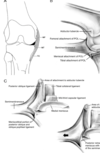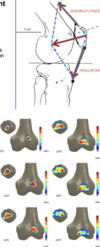other Flashcards
1
Q
typical joint elements – synovial joints
A
- proximal and distal bone
- articular/hyaline cartilage
- capsule
- ligaments
- synomivial membrane synovial fluid

2
Q
hilton’s law
A
- john hilton, british surgeon
- joint innervation
- a nerve that innervates a joint also tends to innervate the muscles that move the joint and the skin that covers the distal attachments of the muscle
- example
- elbow: radial, median, musculocutaneous, ulnar nn.
- knee: femoral, sciatic (fibular and tibial), obturator nn.
3
Q
fibrocatilage in synovial joints
A
- meniscus, articular disc, laburm
- present in tibiofemoral, glenohumeral, acromioclavicular, sternoclavicular, termporomandibular, femoroacetabular
- purpose: to distibute compressive forces, provide additional joint stability/congruency

4
Q
types of synovial joints
A
- plane (gliding)
- acromioclavicular
- hinge (ginglymus)
- humeroulnar, tibiofemoral
- sellar (saddle)
- sternoclavicular
- ellipsoidal (condyloid)
- 2nd MCP
- ball and socket
- glenohumeral
- trochoid (pivot)
- proximal radioulnar (supination/pronation)

5
Q
planar joint
A
- lack of convexity/concavity along surfaces
- primary motion is gliding of two surfaces on one another
- examples
- AC joint
- SI joint
- most spinal facet joints
6
Q
hinge joint
A
- ginglymus
- stable
- examples
- humeroulnar
- tibiofemoral
7
Q
sellar (saddle) joint
A
- examples
- sternoclavicular joint
- 1st carpometacarpal joint (thumb)
- sternoclavicular joint
8
Q
ellipsoidal jiont
A
- CC and CV in all planes
- ligaments provide stability
- example
- metacarpal phalangeal joints

9
Q
pivot (trochoid) joint
A
- examples
- atlantoaxial
- proximal radioulnar

10
Q
convex on concave rule
A
roll and slide/glide opposite

11
Q
concave of convex rule
A
roll and slide/glide same diraction

12
Q
joints of the shoulder girdle
A
- sternoclavicular: only attachment of shoulder to body
- acromioclavicular: link to skeleton
- glenohumeral
- scapulothoracic: pseudojoint, only muscular attachments
13
Q
importance of scapular positioning
A
- glenoid moves like a seal’s nose to remain in right spot to control ball/head of humerus
14
Q
scapulohumeral rhythm
A
- consists of integrated movements of GH, ST, AC, and SC joints
- occurs in sequential fashion to allow full functional motion of shoulder complex
- serves three purposes
- allows for greater overall shoulder ROM
- maintains optimal contact between humeral head and glenoid fossa
- assists with maintaining optimal length-tension relationship of glenohumeral muscles
- for stability
15
Q
evidence summary on arm elevation
A
- scapular upward rotation may be greater on non-dominant side
- scapulohumeral rhythm between 1:3 and 1:5 depending on plane of humeral motion, side of dominance and age of patient
- unilateral or bilateral movement alters scapular and thoracic movement patterns
16
Q
role of thoracic spine
A
- bilateral shoulder motion: 10-30 degrees of thoracic extension (primarily lower) with full shoulder elevation
- unilateral shoulder motion: 10-30 degrees of thoracic rotation and/or side bending
- clinical relevance: assess thoracic motion in patients with shoulder symptoms













